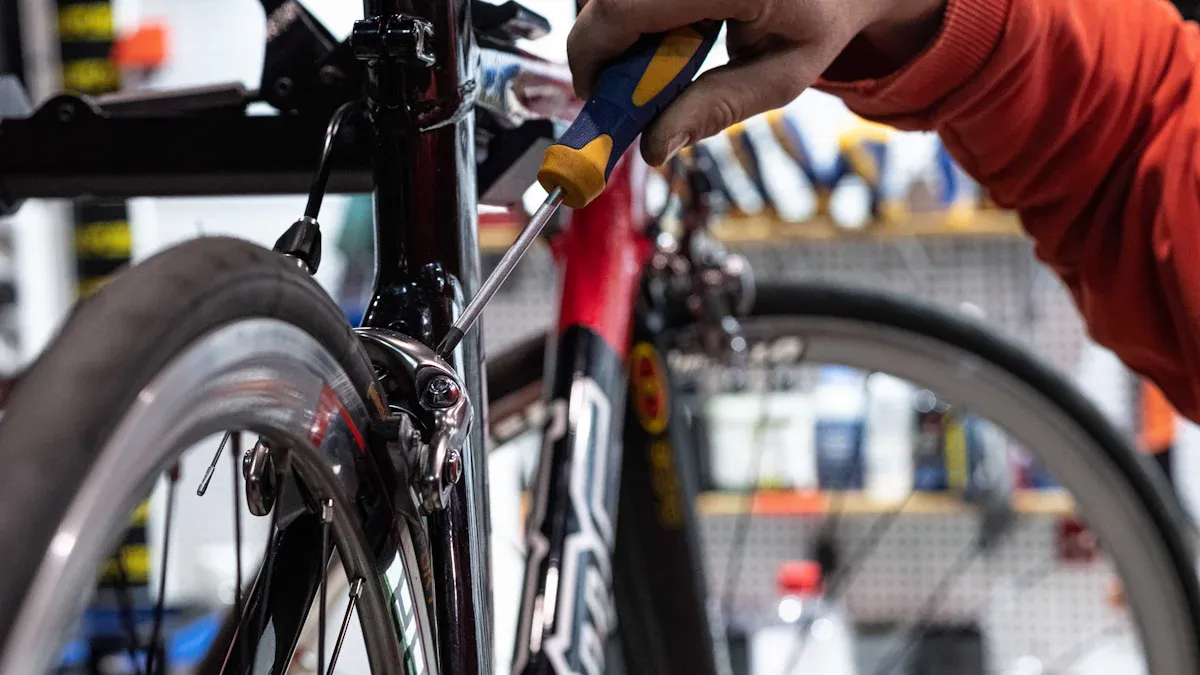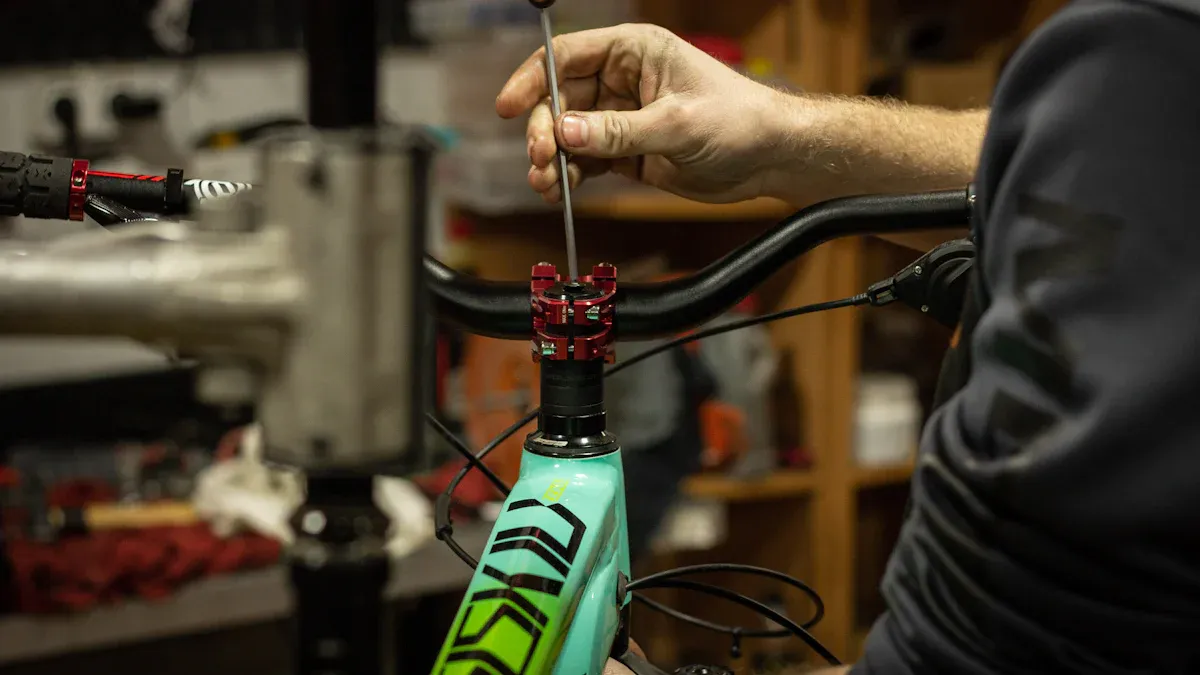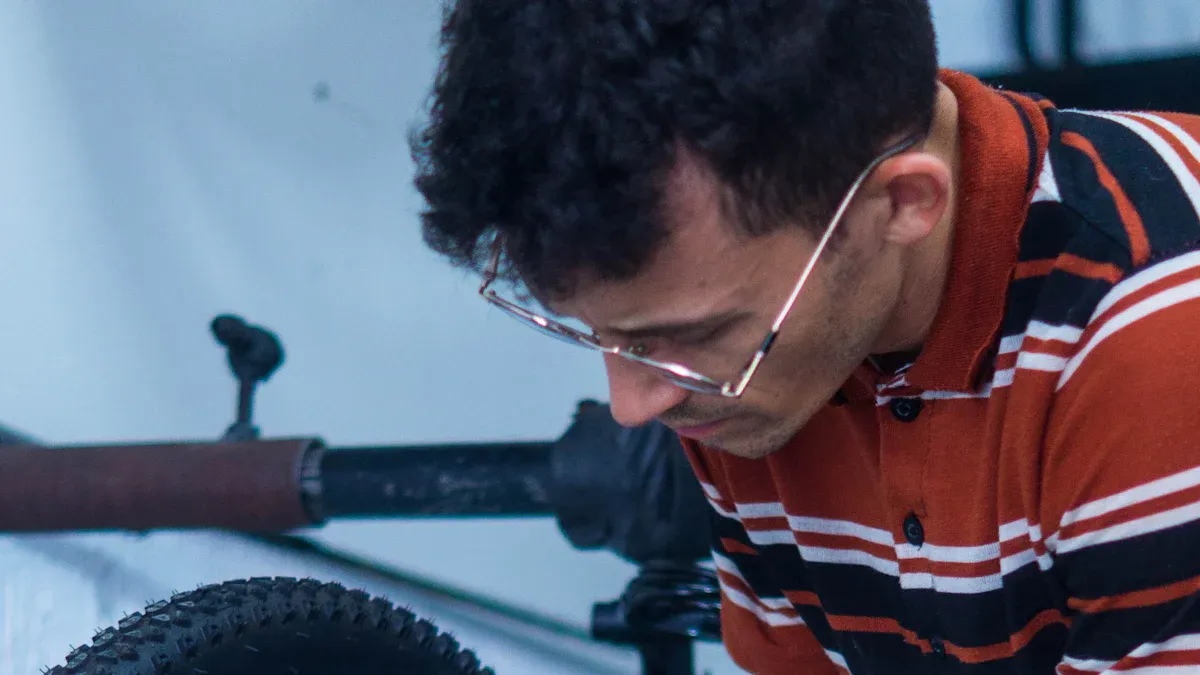
You ride your bike, enjoying the fresh air and freedom. Suddenly, you notice a bike frame dent that wasn’t there before. This dent can affect your bike’s performance and safety. Ignoring it could lead to bigger problems down the road. Taking the time to repair a bike frame dent can keep your ride smooth and safe.
Key Takeaways
Use the correct tools and materials to fix bike frame dents safely.
Look closely at your bike frame for cracks before you start repairs. This helps avoid safety risks.
Repair methods change based on the frame material. Steel dents can be filled or pulled out. Aluminum dents need careful filling and sanding.
Always wear protective gear like gloves and safety glasses when fixing your bike. This helps prevent injuries.
Get the dent area ready and finish repairs with good painting or coating. This protects your bike and keeps it looking nice.
Tools for Bike Frame Dent Repair

Essential Tools
When you want to fix a dent in your bike frame, having the right tools is very important. Here’s a list of tools you should have:
Small pulling tools: These stick to the dent with hot glue. Look for glue tabs and crossbar dent pullers.
Frame blocks: These clamp on both sides of the tube to help push out dents.
Picks or jeweler’s hammers: Use these to tap out high spots from inside the frame.
Brazing equipment: This helps fill dents, especially if you will powder coat later.
General bike maintenance tools: A repair stand is key for holding your bike steady during repairs.
Recommended Materials
Choosing good materials is just as important as having the right tools. Here’s a table showing some useful materials for bike frame dent repair:
Material | Dent Resistance & Impact Behavior | Fatigue Life & Durability | Corrosion Resistance & Other Notes |
|---|---|---|---|
Titanium | Most dent resistant among metals; strong and lasts long. | Can handle many cycles below stress limit; easy to see cracks. | Does not rust; needs treatment to prevent galvanic corrosion; very reliable for strength. |
Aluminum (6061-T6) | Strong and resists rust; cracks instead of dents under force. | Long life if designed well; modern designs use thicker walls and supports. | Forms a protective layer against rust; better for wet areas; improved from older aluminum frames. |
Steel | Strong; bends instead of cracking; can rust easily. | Can last a long time but may weaken from rust over time. | Rusts quickly unless treated; heavier than aluminum and titanium. |
Less dent resistant; damage is often inside and hard to find. | Repairs are easy and not too expensive; damage can be serious if not found. | Not good for rough use or dent resistance; needs good manufacturing for strength and lightness. |
For steel frames, think about using fillers like JB Weld or Bondo for good dent repair. For aluminum frames, welding or brazing is usually not a good idea because it can weaken the material. Instead, use fillers to fix any bumps.
By having the right tools and materials, you can fix bike frame dents easily and well.
Repair Methods for Dents

Small Steel Dents
If you find a small dent in your steel bike frame, you can fix it in different ways. Here are some methods to try:
Metal Fillers: You can use low-temperature solder, 56% silver braze, or brass/bronze to fill the dent. These materials work well, especially if you want to powder coat the frame later.
Rolling Out Dents: Take off the bottom bracket and use metal tube blocks to roll out the dent. This way, you need fewer fillers and lower the chance of hurting the frame.
Cosmetic Repairs: For cosmetic fixes, you can use fillers like Bondo or JB Weld. These options are easier for beginners and can give a smooth finish.
Tip: Be careful when filing the dent. Filing too much can create stress risers that weaken the frame. Try to file only as much as needed.
Medium Steel Dents
Medium-sized dents in steel frames need more attention. Here are some good procedures:
Heat Manipulation: A skilled frame builder can heat the dented area. They can twist or roll it to pop the dent out. This method works well but needs skill.
Dent Pulling: You can take your bike to a body shop. There, a metal wire is spot welded to the dent. A dent puller can then pull out the dent, followed by sanding and refinishing.
Considerations: Remember that these repairs might damage the paint. You may need to repaint the area, which can cost from cheap powder coating to expensive wet paint jobs.
Note: Fixing medium dents is mostly cosmetic. If the frame’s strength is very important, think about replacing the tube instead.
Aluminum Dents
Fixing dents in aluminum frames is quite different from steel. Here are some good methods:
Heat and Cold Application: Use heat and cold to reshape small to medium dents. This method uses thermal expansion and contraction to restore the frame’s shape.
Filling and Sanding: For deeper dents, apply special fillers and sand gradually to get a smooth surface. This step is important for looks and protection.
Carbon Fiber Repairs: Sometimes, you can use carbon fiber to fix aluminum dents. But this needs expert surface preparation and bonding techniques.
Caution: Do not weld repairs on aluminum frames. The material makes it hard to repair well. Instead, focus on cosmetic fixes or wait and check for cracks.
By knowing these methods, you can fix bike frame dents and keep your bike working well and safe.
Safety Considerations
Inspecting for Cracks
Before fixing any dents in your bike frame, check for cracks. Cracks can make the frame weak and cause safety problems. Follow these steps to inspect carefully:
Use a flashlight to look at welds, tubes, and hard-to-see spots on the bike frame. Focus on high-stress areas like the head tube, seat tube, and chainstay.
Run your fingers gently along the tubes to feel for dents, cracks, or bumps that you might not see right away.
Look for rust or corrosion, which can show hidden damage.
Pay close attention to spots around dents or hits, both before and after repairs, to check for new or worse cracks.
Take clear photos or videos of any cracks or damage from different angles. Include a size reference like a ruler or coin.
Stop riding right away if you think there are cracks or hear strange noises or feel unusual flex in the frame.
Don’t try DIY repairs unless you are a skilled frame builder with the right tools and knowledge for the frame material.
Get a professional opinion from a qualified bike mechanic or frame repair expert. They can do detailed checks, possibly using advanced tools like dye penetrant tests, tap tests, or ultrasound for carbon fiber frames.
Safely transport the bike to the expert without riding it if you suspect cracks.
After dent repairs, do thorough inspections again to make sure no new cracks have appeared and that the frame is still strong.
Note: Regular inspections help catch problems early. This can save you money on repairs and keep you safe while riding.
Using Protective Gear
When fixing your bike frame, safety is very important. Wearing protective gear can help prevent injuries during repairs. Here are some must-have items:
Safety Glasses: Protect your eyes from flying debris or metal pieces.
Gloves: Wear strong gloves to protect your hands from sharp edges and chemicals.
Dust Mask: If you are sanding or using fillers, a dust mask can keep your lungs safe from harmful dust.
Knee Pads: If you need to kneel while working, knee pads can make it more comfortable and protect your knees.
Tip: Always work in a well-ventilated area. This helps reduce the risk of breathing in fumes from adhesives or fillers.
Welding to fix dents in aluminum bike frames can be tricky. Aluminum usually needs heat treatments after welding, which are hard to do on bike frames. While welding might work for steel frames, aluminum frames can crack and hold moisture. Always think about the risks and benefits before trying these repairs. It’s best to get professional advice first.
By following these safety tips, you can keep yourself and your bike frame safe during repairs. Remember, a safe repair is a successful repair!
Tips for Successful Bike Frame Dent Repair
Preparing the Area
Before you fix a dent in your bike frame, getting ready is very important. Follow these steps to make the repair easier:
Clean the Area: First, clean the dented spot well. Use a rust remover like Krud-Kutter to get rid of rust without sandblasting right away.
Avoid Early Sandblasting: Wait to use fine abrasive blasting until later. This keeps the frame strong during the first repairs.
Use Precise Tools: Use small tools like variable speed rotary grinders or pneumatic die grinders. These tools help you reach tight spots easily.
Avoid Flat Sanders: Don’t use flat sanders on tubing. They can make flat spots that show up after painting.
Flexible Abrasive Discs: Use these discs to take off old paint, rust, and mill-scale from the tubing. This step is key for good bonding of fillers or paint.
Getting ready properly affects how strong your bike frame will be after repairs. You want to make sure the new materials stick well to the old frame.
Finishing Touches
After you finish the dent repair, focus on the last steps to make your bike look good again. Here are some helpful techniques:
Apply Primer: Use a zinc-based primer to stop rust. This acts as a protective layer and should go on before the final coat.
Choose Your Finish: You can pick brushing, spraying, or powder coating:
Brushing: This method is easier but might not look the best. Marine epoxy enamel is good for lasting strength.
Spraying: This classic method can be simple spray cans or professional auto body work. Make sure to take safety steps because of fumes.
Powder Coating: This means baking the finish and gives a strong, easy-to-touch-up option.
Multiple Thin Layers: When you paint, use several thin layers. Let each layer dry completely before adding the next. This builds thickness and gives a smooth finish.
Final Touches: After the paint dries, sand the area with fine emery paper to blend the new paint with the old. Finish with a clear lacquer or wax polish to protect the repair and bring back shine.
By following these tips, you can make a repair that looks professional and improves both the safety and look of your bike frame.
In conclusion, fixing dents in your bike frame is important for safety and performance. You learned about different tools, like pulling tools and frame blocks. You also learned methods for materials such as steel and aluminum.
Keep in mind, well-repaired dents can make your bike last longer. Dents in aluminum frames can cause serious safety issues if not fixed. Always check for cracks before starting repairs.
Take action now! With the right methods and safety steps, you can fix your bike frame and have a smoother ride. Enjoy cycling! 🚴♂️
FAQ
What should I do if my bike frame has a dent?
Look closely at the dent for cracks. If there are none, pick a repair method that fits the frame material. Use the right tools and materials to fix the dent safely.
Can I repair aluminum bike frames myself?
Yes, you can fix aluminum frames, but don’t weld them. Instead, use fillers and sanding for cosmetic fixes. Make sure to follow safety rules while you repair.
How can I prevent future dents in my bike frame?
Keep your bike in a safe spot, away from heavy things. Use a bike rack or stand to stop accidental falls. Check your bike often for any signs of damage.
When should I seek professional help for bike frame repairs?
If you see cracks or major damage, ask a professional for help. They have the skills and tools to keep your bike safe and working well. Don’t risk your safety with DIY repairs.
How often should I inspect my bike frame for damage?
Check your bike frame regularly, especially before long rides. Look for dents, cracks, and rust. Finding problems early can stop serious issues and keep your bike in great shape.
